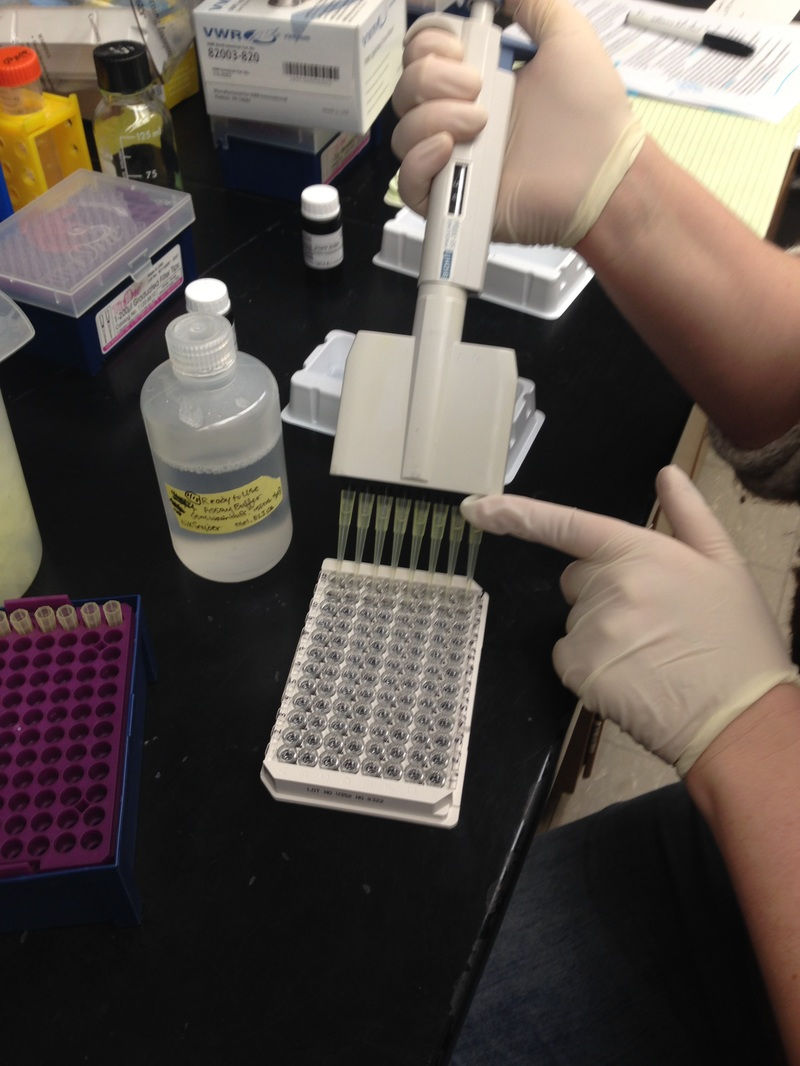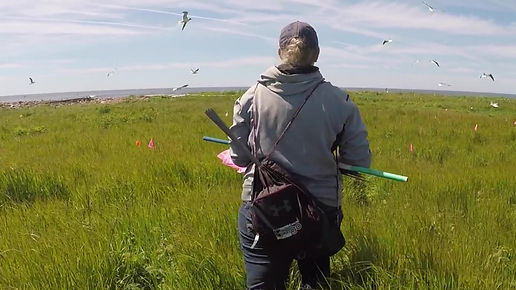

RESEARCH
Eco Evo Devo
For my graduate work, I explored how avian embryos detect, integrate, and respond to seasonal cues during incubation, with particular focus on maternal yolk hormones and photoperiod.
Questions I'm currently investigating:
1) Do embryos have receptor protein to detect hormonal cues very early in embryo genesis?
2) Can embryos detect differences in photoperiod and hormone cues?
3) Can embryos integrate & prioritize cue information?
4) Do embryos respond to variation in cues & does this response occur early in development or later in life as a trade off?
More broadly I am interested in the evolution of phenotypic plasticity of the embryo--embryos' amazing ability to use the same genetic blueprint but produce wild differences in expression of those genes.

[Eco-Evo-Devo]
Ecological-Evolutionary-Developmental Biology
Integrative approach to "uncover the rules that underlie the interactions between an organism's environment, genes, and development and to incorporate these rules into evolutionary theory."
-Abouheif et al. (2014). Adv Exp Med Biol.

Integrative Approaches
EXPERIMENTAL
manipulate photoperiod, block hormone receptor function
EXPERIMENTAL
ECOLOGICAL
monitor nesting metrics in wetlands, correlated weather data, trap/band adult birds and chicks to capture full life cycle, transects across field sites
ECOLOGICAL
Primarily work on wetland migratory wild birds, especially gulls. Focus on developmental programming that occurs very early in embryogenesis, by integrating a variety of experimental, biochemical, physiological, and ecological field techniques.
PHYSIOLOGICAL
hormone injection studies in eggs and adults, analyze combined behavior/ function/hormone response to stimuli, organ system cross talk
PHYSIOLOGICAL
BIOCHEMICAL
ELISA and comet assays, genetic or hormone extractions, PCR, gel electrophoresis, western blotting, bacteria culture, microbiome
BIOCHEMICAL
MODEL SPECIES
Franklin's gull, Laughing gull,
red-winged blackbird, poultry, quail
MODEL SPECIES
Future Directions
Elucidate the dimensions of the embryo's sensitivity to yolk melatonin in chicken model using the '3D Critical Windows' framework proposed by Burggren and Mueller (2015) to better understand melatonin's overall role in embryo growth and development.

Explore underlying molecular mechanisms of seasonal patterns in offspring using RNASeq data to identify differential gene expression patterns.

Use genomic information to reveal evolutionary differences among closely related species of gull to provide insight into conserved vs. flexible mechanisms in development.

Pons, Hassanin, Crochet. (2005) Molec. Phylo. Evo.
Implications
Our research has the potential to impact several fields of research including:
* Conservation:
predict developmental vulnerability to climate change
* Human Health:
improve fetus health and disease outcomes with novel melatonin treatments during pregnancy
* Agriculture:
if we can figure out how 'better' chicks are made, producers can increase yield and improve efficiency of economically important bird species (think chicken eggs and pheasant hunting)
However we must remember!!
Even basic science is inherently important because we cannot predict what new and interesting applications of our findings will be essential for future generations of people and scientists.

STEM Education Research

While teaching science general education labs, I became interested in meta-cognitive processes students use to learn and how instructors can use that information to help students develop transferable skills.
1) Specifically I wondered what makes a 'good question' in biology?
2) How does a student develop 'question asking' as a skill?
3) How does this skill evolve across a semester and ultimately
throughout a student's learning career?
Developed a rubric to evaluate Bloom's Levels of student generated questions and deployed a 'muddiest point' tool after every lab. We found targeted instruction on what makes a good question, repeated practice, and directed feedback with our rubric led students ask double the number of voluntary questions. Students also began asking higher level questions, including testable questions most often associated with graduate level training.

More broadly and after teaching upper-division courses, I am interested in how students are motivated during the learning process. I wonder if our previous findings had somehow shifted learning from external to intrinsic motivation leading me to ask:
1) Can we 'biohack' motivation with intentionally designed learning
tools and learning environments to make classrooms more equitable and just for diverse populations of students?
2) Can these intentional tools be used to foster curiosity and
improve students' question-asking skills?
Although most of these avenues were pilot studies, my work inspired research for a newly hired faculty and initiated cross-departmental collaboration. In future work, I'm interested in applying the framework from my PhD of 'Survival=Detect+Integrate+Respond' to the neurophysiological context of student cognition:
Learning =
Intake (detecting multi-modal sources of info, avoiding overload, selective screening of initial info--conscious or unconscious) +
Integrate (prioritization of information, psychological condensing of stimuli information, inserting info into conceptual frameworks) +
Respond (store in memory, apply, etc.)
From an evolutionary standpoint, I wonder if plasticity exists in cognitive phenotypes of developing brains in similar manner to phenotypic plasticity in development of embryos.
Project List
















Graduate School
2020-present: Pan-American hooded gulls de novo genome sequencing project.
2018-2022: Assessing nesting phenology of Laughing gulls and yolk hormone
investments.
2017-2019: Lowering the activation barrier, not the academic bar: The role of
contract grading in decreasing DFW rates in large-lecture life sciences (collaborator).
2017: Determining antibody use for melatonin receptor expression Franklin's
gull embryos.
Pilot Killdeer nesting study.
2016-2019: Using course artifacts to improve teaching and learning in science
general education courses (collaborator).
2015-2016: Manipulating melatonin and receptor signaling in chicken embryos.
2014-2016: Investigating hormone investments in Franklin's gull eggs.
"Predicting phenotypes: how offspring integrate cues of season from environment and mothers"
Undergraduate
2013-2014: Determining affect of predator effigies on red-winged blackbird
stress response and nesting behavior (intern).
2013: Measuring effectiveness of sunflower Avipel repellent spray on red-
winged blackbird feeding behaviors (intern).
2013: Sequencing melatonin receptors in Franklin's gull embryos (independent
project).
2012: Tracking developmental accumulation in DNA damage via COMET assay
(independent project) and rearing Franklin's gull chicks in the lab (intern).
2011-2015: Quail husbandry.

Publications & Presentations
Publications
2019 Boertje, E., Snyder, N., Reed, W., Kittilson, J. and Clark, M. (2019). Testosterone (T) and Triiodothyronine (T3) in Franklin’s Gull (Leucophaeus pipixcan) Eggs. Waterbirds.
2022 Snyder, N., Dickerman, L., Altaf, A., Kittilson, J., Clark, M., and Reed, W. Melatonin and Melatonin Receptor Signaling in Growth and Development of the Chicken Embryo. Preparing for alternate journal submission.
Talks
2017 Snyder, N., Dickerman, L., Altaf, A., Kittilson, J., Clark, M., Reed, W. Predicting early embryo phenotype through maternally yolk-mediated environmental cues. The Waterbird Society, Reykjavik, Iceland.
2016 Snyder, N., Altaf, A., Reed, W., Clark, M. and Kittleson, J. Inside the egg: Patterns of variation in melatonin in Franklin's gulls eggs. Society of Integrative and Comparative Biology, Portland, OR; Northern Plains Biological Symposium, Fargo, ND.
Posters
2019 Snyder, N., Dickerman, L., Reed, W. Seasonal Trends in Nesting Physiology of Adult Laughing Gulls. Society of Integrative and Comparative Biology, Palm Springs, FL and World Seabird Twitter Conference.
2017 Snyder, N., Dickerman, L., Altaf, A., Clark, M., Reed, W. Melatonin and Receptor Signaling: Investigating Roles in Chicken Embryo Development. Society of Integrative and Comparative Biology, New Orleans, LA.
2013 Snyder, N., Reed, W., and Clark, M. Growth and Immune System Function in Juvenile Franklin’s Gull. Society of Integrative and Comparative Biology, San Francisco, CA.
High School and Undergraduate Mentee’s Presentations
2019 Sydney, Y., Snyder, N., Reed, W. Effects Inclement Weather on Maternal Investments in Laughing Gull Eggs. NDSU Explore Undergraduate Showcase, Fargo, ND.
2016 Schwalbe, M., Snyder, N., Momsen, J. A Pilot Study Using Course Artifacts to Improve Teaching and Learning in Science General Education. NDSU Explore Undergraduate Showcase, Fargo, ND.
2016 Dickerman, L., Snyder, N., Clark, M., Reed, W. Melatonin and Receptor Signaling: Investigating Roles in Chicken Embryo Size Development. NDSU Explore Undergraduate Showcase, Fargo, ND. *2nd place best student poster
2016 Labuhn, M.#, Singh, A.#, Snyder, N., Schwalbe, M., Dickerman, L., and Reed, W. Impacts of melatonin dosage and melatonin’s receptor signaling on early chicken (Gallus gallus) embryo development. ND Gov.’s School, Fargo, ND. #equal contributions.
2015 Altaf, A., Snyder, N., and Reed, W. Impacts of melatonin dosage and melatonin antagonist, a pilot study. ND Governor’s School Conference, Fargo, ND AND Society of Integrative and Comparative Biology, Portland, OR.

